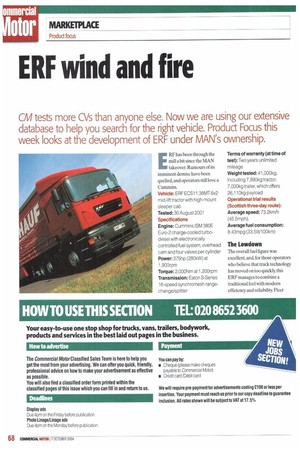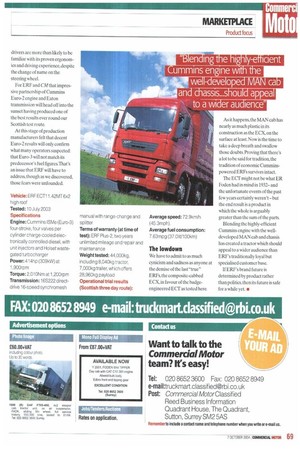ERF wind and fire
Page 70

Page 71

If you've noticed an error in this article please click here to report it so we can fix it.
CM tests more CVs than anyone else. Now we are using our extensive database to help you search for the right vehicle. Product Focus this week loos at the development of ERF under MANN ownership.
ERF has been through the mill a bit since the MAN takeover. Rumours of its imminent demise have been quelled, and operators still love a Cummins.
Vehicle: ERF ECS11.38MT 6x2 mid-lift tractor with high-mount sleeper cab Tested: 30 August 2001 Specifications
Engine: Cummins ISM 380E Euro-2 charge-cooled turbodiesel with electronically controlled fuel system, overhead cam and four valves per cylinder Power: 375hp (280kW) at 1,90Orpm Torque: 2,000Nm at 1,200rpm Transmission: Eaton S-Series 16-speed synchromesh rangechange/splitter Terms of warranty (at time of test): Two years unlimited mileage Weight tested: 41,000kg, including 7,890kg tractor, 7,000kg trailer, which offers 26,110kg payload Operational trial results (Scottish three-day route): Average speed: 73.2km/h (45 5mph).
Average fuel consumption: 8.43mpg (33.51it/100km)
The Lowdown
The overall fuel figure was excellent, and, for those operators who believe that truck technology has moved on too quickly this ERE manages to combine a traditional feel with modern efficiency and reliability. Fleet drivers are more than likely to be familiar with its proven ergonomics and driving experience, despite the change of name on the steering wheel.
For ERF and CM that impressive partnership of Cummins Euro-2 engine and Eaton transmission will head off into the sunset having produced one of the best results ever round our Scottish test route.
At this stage of production manufacturers felt that decent Euro-2 results will only confirm what many operators suspected: that Euro-3 will not match its predecessor's fuel figures.That's an issue that ERF will have to address, though as we discovered, those fears were unfounded.
Vehicle: ERF ECT11.42MT 6x2 high roof Tested: 10 July 2003 Specifications Engine: Cummins ISMe (Euro-3) four-stroke, four valves per cylinder charge-cooled electronically controlled diesel, with unit injectors and Holset wastegated turbocharger Power: 414hp (309kW) at 1,90Orpm Torque: 2,010Nm at 1,200rpm Transmission: 16S222 directdrive 16-speed synchromesh manual with range-change and splitter Terms of warranty (at time of test): ERF Plus-2, two years unlimited mileage and repair and maintenance Weight tested: 44,000kg, including 8,040kg tractor, 7,000kg trailer, which offers 28,960kg payload Operational trial results (Scottish three day route): Average speed: 72.9km/h (45.3mph).
Average fuel consumption: 7.63mpg (37.01it/100km)
The lowdown
We have to admit to as much cynicism and sadness as anyone at the demise of the last "true" ERFs, the composite-cabbed ECX, in favour of the badgeengineered ECT as tested here. As it happens, the MAN cab has nearly as much plastic in its construction as the ECX, on the surface at least. Now is the time to take a deep breath and swallow those doubts. Proving that there's a lot to be said for tradition, the tradition of economic Cumminspowered ERFs survives intact.
The ECT might not be what ER Foden had in mind in 1932—and the unfortunate events of the past few years certainly weren't— but the end result is a product in which the whole is arguably greater than the sum of the parts.
Blending the highly-efficient Cummins engine with the welldeveloped MAN cab and chassis has created a tractor which should appeal to a wider audience than ERF's traditionally loyal but specialised customer base.
If ERF's brand future is determined by product rather than politics, then its future is safe for a while yet. •






























































































































































































